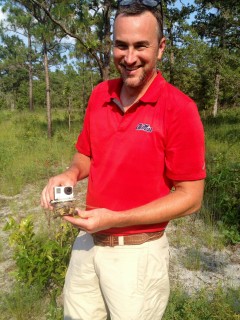Storytime with SouthDocs: Rex Jones Explores the Longleaf Pine
This story, by Rebecca Lauck Cleary, originally appeared in the Summer 2014 Southern Register. Check out the Register page for more.
 Longleaf Pine Ecosystem Subject of Latest SouthDocs Project
Longleaf Pine Ecosystem Subject of Latest SouthDocs Project
Southern Documentary Project producer Rex Jones is merging a love of nature and storytelling with his latest film about the longleaf pine ecosystem. Jones, who specialized in natural resources media and nature videography while earning an MFA in science and natural-history filmmaking from Montana State University, hopes to incorporate both of his interests in this documentary.
SouthDocs director Andy Harper knew that Jones would eventually work on this project. “As a historian of the Southern environment,” Harper says, “I always hoped that we would get around to making a film about the longleaf. When we hired Rex I knew that he would be the one to eventually make that film.”
 Jones recently interviewed Don McAllister, who searches the Suwannee River to find submerged logs to sell to George Goodwin, owner of a heart pine company in Micanopy, Florida. The Goodwin Company has earned a reputation as one of the most highly respected manufacturers of antique heart pine and heart cypress in the world. While interviewing McAllister, the diver pulled up a six-and-a-half-foot-wide and 30-foot-long cypress log.
Jones recently interviewed Don McAllister, who searches the Suwannee River to find submerged logs to sell to George Goodwin, owner of a heart pine company in Micanopy, Florida. The Goodwin Company has earned a reputation as one of the most highly respected manufacturers of antique heart pine and heart cypress in the world. While interviewing McAllister, the diver pulled up a six-and-a-half-foot-wide and 30-foot-long cypress log.
Originally, the longleaf pine ecosystem stretched across the South from the tip of Virginia to Florida to east Texas. Before the Civil War, there were 90 million acres, which were cut to two million acres by the end of the Great Depression.
“Wood like this isn’t being made anymore, and McAllister’s and Goodwin’s work are examples of how you can be environmentally friendly and sustainable,” Jones says. “I’ll also be looking at the fauna associated with longleaf pine, such as gopher tortoises, gopher frogs, sandhill cranes, and red cockaded woodpeckers—animals that are keystone species of the longleaf ecosystem.”
For this vast topic, Jones realizes the length of the documentary may need to be longer than some of his past work. “It might be a three-part feature, with an hour each on history, ecology, and the restoration-preservation aspect,” he says. “It’s important to follow this through the seasons of the year, because different things are happening at different times with the rhythms of nature. It is one of the most biologically diverse ecosystems in the world.”
